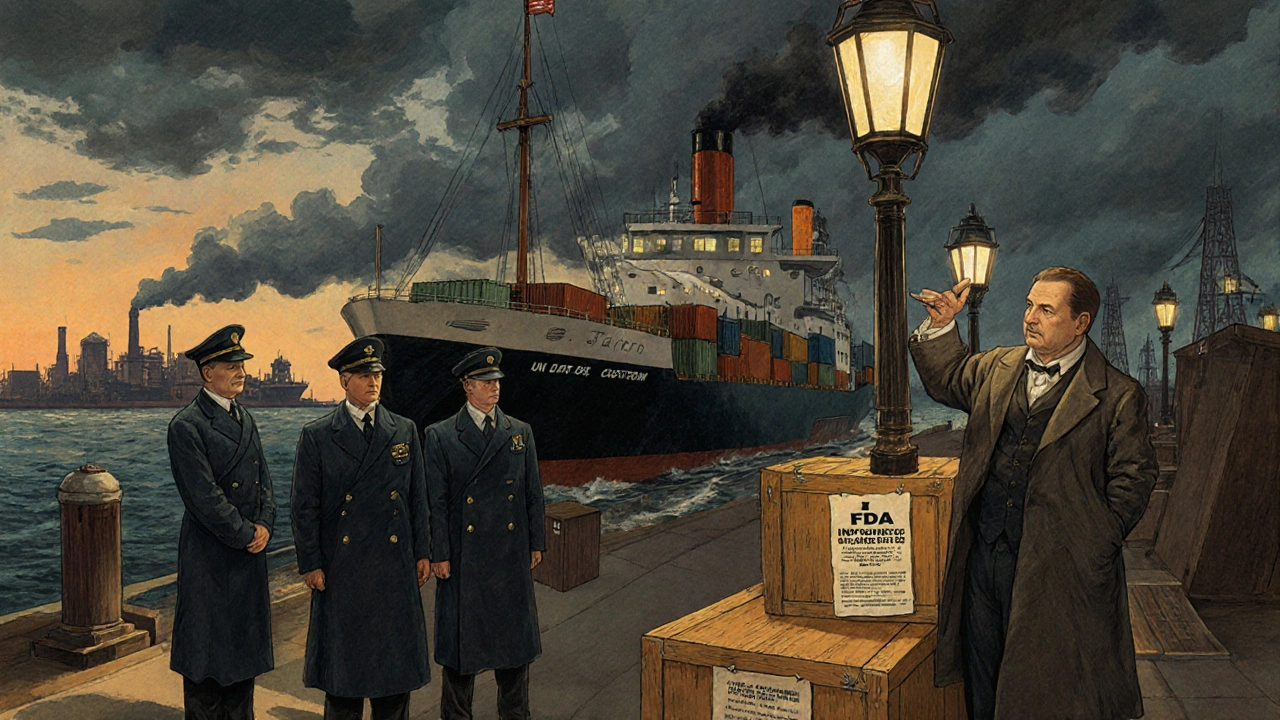The U.S. Food and Drug Administration doesn’t just monitor products-it enforces them. When manufacturers cut corners, mislabel drugs, or sell unapproved tobacco products, the FDA doesn’t wait. It acts. And its most powerful tool isn’t a fine or a seizure-it’s the Warning Letter.
What a Warning Letter Really Means
A Warning Letter from the FDA isn’t a polite reminder. It’s a formal notice that your company has broken the law. These letters are issued when inspectors find violations during facility inspections, when products are flagged at the border, or when marketing claims cross legal lines. The FDA doesn’t send these lightly. They’re reserved for violations of “regulatory significance”-meaning the risk to public health is real.Here’s how it works: After an inspection, if FDA inspectors find issues, they issue an FDA Form 483 listing observations. If those issues aren’t fixed or are serious enough, the agency follows up with a Warning Letter. The letter names the violation, cites the exact law broken (like Section 502(a) of the Federal Food, Drug, and Cosmetic Act), and gives the company 15 business days to respond with a plan to fix it. No response? Or a weak one? That’s when the FDA escalates.
What’s changed? In 2023, FDA Commissioner Robert Califf announced a return to the 1990s enforcement model-hundreds of warning letters per year. That’s not a coincidence. The agency is now more aggressive, more centralized, and less tolerant of delays. Warning Letters now come signed by directors of CDER (Center for Drug Evaluation and Research) or CBER (Center for Biologics Evaluation and Research), not junior reviewers. That signals the agency’s top leadership stands behind each letter.
How the FDA Escalates Beyond the Letter
A Warning Letter is just the first step. If you ignore it, the FDA has a full toolkit to shut you down:- Import Alerts: Products get detained at the border without physical inspection. No paperwork, no second chance-just blocked entry.
- Civil Monetary Penalties: Fines can hit $1 million per violation under 21 U.S.C. § 333(f). For repeat offenders, these pile up fast.
- Recalls: The FDA can demand a recall-voluntary or mandatory. If you refuse, they can seize your product.
- Withdrawal of Approval: For drugs or biologics, the FDA can pull authorization entirely. No more sales. No more distribution.
- Criminal Charges: If you lie to inspectors, hide records, or block access to facilities, you could face federal criminal prosecution under Section 303(f) of the FDCA.
Foreign manufacturers aren’t safe. Since May 2025, the FDA has ramped up unannounced inspections of overseas facilities by 300%. These inspections are designed to catch cGMP (Current Good Manufacturing Practice) failures before products even reach U.S. soil. And if you refuse access? That’s not just a violation-it’s a criminal offense.

Where the FDA Is Hitting Hardest in 2025
Not all industries are targeted equally. The FDA has sharpened its focus on three high-risk areas:1. Compounded GLP-1 Drugs
In the first half of 2025 alone, the FDA issued 58 Warning Letters to compounding pharmacies and telehealth companies selling unapproved versions of semaglutide and tirzepatide. These are the same drugs used in weight-loss treatments like Ozempic and Mounjaro. But when pharmacies compound them without approval, mislabel them as “custom” or “non-FDA approved,” and market them aggressively online, they’re breaking the law. The FDA’s message is clear: You can’t bypass approval just because demand is high.2. Unauthorized Tobacco Products
The FDA has issued over 700 Warning Letters since 2021 targeting companies selling new tobacco products without marketing authorization. Most of these involve electronic nicotine delivery systems (ENDS)-vapes with flavors like mango or bubblegum that appeal to teens. Even if a company claims their product is “not for minors,” if it’s sold without FDA review, it’s illegal. The agency is prioritizing youth protection above all else.3. Food Safety Violations
In 2024, the FDA issued 149 Warning Letters to human food manufacturers and 37 to animal food producers. These aren’t about dirty floors anymore. They’re about failing to implement Hazard Analysis and Risk-Based Preventive Controls (HARPC) under the Food Safety Modernization Act (FSMA). That means no more guessing-facilities must prove they’ve identified risks and put controls in place. If you haven’t updated your food safety plan since 2015, you’re already out of compliance.What Companies Must Do When They Get a Letter
Receiving a Warning Letter isn’t the end-but ignoring it is. Here’s what successful companies do:- Don’t panic, but act immediately. Treat this like a regulatory emergency. The 15-day clock starts the moment you open the email.
- Assemble your team. Legal, quality control, regulatory affairs, and senior leadership must all be involved. One department can’t fix this alone.
- Respond with proof, not promises. Your response must include specific actions taken, dates, evidence (photos, training records, revised SOPs), and a timeline for full compliance. Vague statements like “we will improve” won’t cut it.
- Prepare for a follow-up inspection. The FDA will come back. They’ll check if your fixes are real. If they’re not, penalties begin.
- Don’t assume it’s over after approval. The FDA keeps records. A past Warning Letter can trigger more scrutiny for years.
Companies that wait until the last day to respond almost always fail. The FDA doesn’t want a perfect plan-they want proof you’re taking responsibility. And they’re watching.

Why This Matters for Everyone
If you buy a drug, eat packaged food, or use a vape, this affects you. The FDA’s crackdown isn’t about bureaucracy-it’s about safety. A single unapproved drug can cause organ damage. A contaminated food batch can trigger a nationwide outbreak. A vape with hidden nicotine can hook a teenager.The agency’s increased enforcement means fewer dangerous products on shelves. But it also means higher costs for compliant manufacturers. Those who cut corners now face steeper consequences than ever before. The message is simple: If you want to sell in the U.S., you play by FDA rules-or you don’t play at all.
What’s Next for FDA Enforcement?
The FDA’s 2026 budget includes $50 million for more inspectors, better digital monitoring tools, and expanded authority to track online marketing. Expect more letters targeting social media ads, influencer posts, and e-commerce listings that make false claims. The agency is also moving toward centralized sign-offs-meaning every Warning Letter now goes through the Office of the Commissioner. This ensures consistency, but it also means fewer exceptions.One thing is certain: The era of lax oversight is over. The FDA is no longer waiting for a crisis to act. It’s using its authority to stop problems before they happen. Manufacturers who adapt will survive. Those who don’t will be removed from the market-quickly and publicly.
What happens if I ignore an FDA Warning Letter?
If you ignore a Warning Letter, the FDA will escalate. This could mean your products are detained at the border, you’ll face civil penalties of up to $1 million per violation, or your product’s approval could be withdrawn entirely. In extreme cases, individuals may face criminal charges for obstructing inspections or falsifying records. The FDA does not warn twice.
Can the FDA shut down a foreign manufacturer?
Yes. The FDA can refuse entry of products from foreign facilities that violate U.S. regulations. They can also issue Import Alerts that automatically detain shipments. Since 2025, unannounced inspections of foreign sites have increased by 300%, and refusal to allow access is now a criminal offense. Many foreign manufacturers have lost U.S. market access because they didn’t respond to inspections or Warning Letters.
Are Untitled Letters still used by the FDA?
Less often. Untitled Letters were once used for minor marketing violations, but since 2023, the FDA has shifted toward issuing Warning Letters even for lower-level issues. This is part of a broader strategy to increase enforcement visibility and pressure companies to respond immediately. For example, the Office of Prescription Drug Promotion now issues Warning Letters instead of Untitled Letters for most promotional violations.
How long does a Warning Letter stay on record?
Warning Letters remain publicly available on the FDA’s website indefinitely. Even after a company fixes the issue and the FDA closes the letter, it stays in the public record. This affects future inspections, investor confidence, and even partnerships. Companies with past Warning Letters often face more scrutiny during subsequent audits.
Can I appeal an FDA Warning Letter?
You can’t formally appeal a Warning Letter, but you can respond with evidence to dispute the findings. If you believe the FDA misinterpreted your practices, your response should include detailed documentation, expert analysis, or prior compliance records. However, the FDA does not withdraw a Warning Letter unless the violation is fully corrected and verified. Simply arguing the letter is unfair won’t change its status.
What’s the difference between a Warning Letter and an FDA Form 483?
An FDA Form 483 is an inspectional observation issued during a facility visit-it’s not a formal enforcement action. A Warning Letter is the next step: a formal, legally significant notice that violations are serious enough to require a written corrective plan. The Form 483 can lead to a Warning Letter, but not every 483 does. Only violations of “regulatory significance” trigger a Warning Letter.


saurabh lamba
November 17, 2025 AT 17:27Kiran Mandavkar
November 17, 2025 AT 19:55Eric Healy
November 19, 2025 AT 13:26Holli Yancey
November 20, 2025 AT 02:34Gordon Mcdonough
November 20, 2025 AT 23:25Jessica Healey
November 22, 2025 AT 13:40Levi Hobbs
November 24, 2025 AT 04:45henry mariono
November 25, 2025 AT 19:25Sridhar Suvarna
November 27, 2025 AT 17:14Joseph Peel
November 28, 2025 AT 20:12